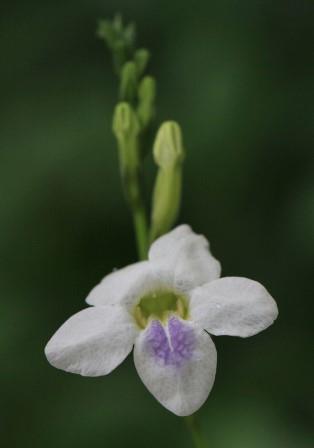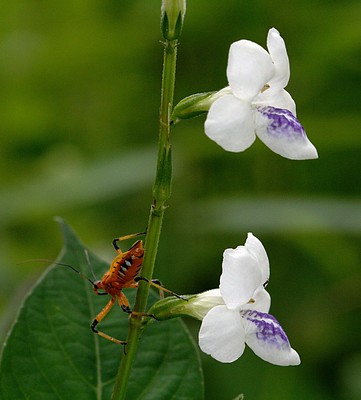It’s also quite endearing with its lovely dark green leaves and profusion of small, fragrant cream flowers which can appear sporadically at any time in spring and summer, and all year round in warm climates. The flower petals have delicate purple streaks in them that act as nectar guides for the host of pollinators that visit the flowers. The flowers resemble foxgloves, hence its common name, Creeping Foxglove. It is also called Rankvingerhoedjie, and Isihobo. The flowers also look remarkably like our indigenous Forest Bell Bush, Bosklokkiesbos, or Mufhanza (Mackaya bella) but the 1.5cm wide blooms are smaller than those of the forest bell bush. The fruit is a small green capsule that ‘explodes’ to disperse the seeds.
Members can click here to read more about Mackaya bella
The similarity between the two comes as no surprise, as both Mackaya bella and Asystasia gangetica belong to the same family (Acanthaceae), and are closely related. The large Acanthaceae family includes other South African garden favourites like the beautiful Black-eyed-Susan, Swartoognooi, or isiPhondo (Thunbergia alata), and the Bush Violet, Kleinbosviooltjie (Barleria obtusa).
Members can click here to read more about Black-eyed Susan
Members can click here to read more about the Bush Violet
Asystasia gangetica is a fast growing, evergreen perennial herb which is widely distributed from tropical Asia to southern Africa. The subspecies found in South Africa differs from the Asian plant which usually has larger pink flowers.
In South Africa it occurs along the eastern coastal areas of the country and in the north, growing wild in the forests and woodlands of the Eastern Cape, KwaZulu-Natal, Limpopo, and Mpumalanga; extending into Swaziland, Mozambique, Botswana, and Namibia. The stems root easily at the nodes, enabling it to spread vigorously, and it can reach a height of 30 to 45cm with a spread of 60cm, but in tropical and subtropical regions it can grow a lot taller, 60cm to 1m in height with an even wider spread. There is a form known as Asystasia gangetica ‘aurea’ that has attractive yellowish-green leaves.
It comes as no surprise that Aystasia gangetica is not threatened in any way in South Africa, and is listed as LC (Least Concern) in the Red Data List. The only bad attribute to be said about this plant is that it is perhaps a bit too obliging, and in the warmer, wetter regions of southern Africa, and elsewhere, it can become invasive in the garden. As long as you are aware of this and are prepared to keep it in check, if necessary, this indigenous plant is lovely in small or large gardens.
As with so many beautiful garden plants that are grown outside their native ranges, Asystasia gangetica can be invasive, and according to the Global Invasive Species Database this creeper is potentially highly invasive. It has been introduced into tropical areas in North, Central and South America, Hawaii, West Indies, and Australia, and has escaped garden cultivation and become a danger for indigenous species. It is included on various lists of invasive plants, including for Cuba, Puerto Rico and Hawaii. It has caused major problems in the ecosystems of the Pacific Islands, and in Australia it is on the National Environmental Alert List, while in Florida it is considered a noxious weed.
Uses:
In some parts of Africa, the leaves are eaten as a vegetable, and used as an herbal remedy in traditional African medicine for the management of asthma.
 Asystasia gangetica. Picture courtesy Nu-leaf NurseryIn the Garden:
Asystasia gangetica. Picture courtesy Nu-leaf NurseryIn the Garden:
Because of its vigorous nature the creeping foxglove is not suitable for very small gardens, but there is no reason why you could not have one in a hanging basket, as the trailing habit of this plant looks quite spectacular in a large basket or tall pot, and can provide a lot of privacy on a small balcony. It can even be trained to climb up a trellis.
If you have a large expanse that needs covering, try the magic of this indigenous beauty. It is a useful groundcover for shady areas under trees, but is equally suited to mass planting in sunny areas, provided the area receives regular irrigation. If you are using it in a large semi-shady space as a groundcover, try planting it with plants like Dietes grandiflora and Clivia miniata for a lovely contrast of colour, form and texture.
Members can click here to read more about the Wild Iris (Dietes grandiflora)
Members can click here to read more about the Bush Lily (Clivia miniata)
It is a must-have for wildlife gardens, and especially for honey bee and butterfly friendly gardens, as it is the larval host to a number of butterfly species, including:. Common Diadem, Yellow Pansy and Blue Pansy, Brown Pansy, Soldier Pansy, Common and Cloudy Mother-of-pearls.
Click here to see Google images of the Common Diadem butterfly
Click here to see Google images of the Yellow and Blue Pansy butterflies
Click here to see Google images of the Brown Pansy butterfly
Click here to see Google images of the Soldier Pansy butterfly
Click here to see Google images of Common and Cloudy Mother-of-pearls butterfly
This plant is also a larval host to some moth species, and insectivorous birds will forage among the plants looking for other insects like beetles that are attracted to the flowers. These insects are also an important food source for frogs and lizards.
 Asystasia gangetica. Picture courtesy Miltos Gikas from flickrCultivation/Propagation:
Asystasia gangetica. Picture courtesy Miltos Gikas from flickrCultivation/Propagation:
The creeping foxglove is an attractive but very vigorous groundcover that tolerates full sun if it is given adequate water. It flowers profusely in a sunny position, but also grows exceptionally well in shade, even deep shade, but in too much shade the flowers are sparse.
In tropical and subtropical areas it can grow rampantly, and the plant is also moderately hardy to cold and frost, but the leaves can die back to soil level if subjected to severe frost. However, the plant will usually regenerate in spring if the roots are mulched in autumn to protect them from the cold.
The creeping foxglove will grow in most soil types given enough compost, and this is especially important if it is planted underneath trees. In the garden, regular feeding in spring and summer, together with regular watering, will keep the plant looking lush, and encourage even more blooms.
It may require regular pruning to keep it in control, and especially if planted underneath trees, as it will willingly grow up the stems trees or anything else in its path.
Propagation is from seed, cuttings, or by removing rooted runners.
Problems, Pests & Diseases:
Like many soft herbs, Asystasyia gangetica is susceptible to attack from dodder (Cuscuta campestris). Dodder is a slender, leafless, parasitic herb with yellow, twining stems reaching a height of up to 2m and forming dense patches up to 5m across. It produces little whitish flowers, followed greenish yellow fruit capsules. Any plants affected by dodder should immediately me removed from the garden and destroyed.
Click here to see Google images of dodder
Warning:
Asystasyia gangetica is not poisonous.



